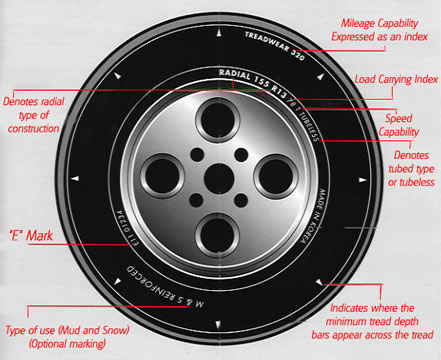Tyre Info

Tyres and the Law
European Regulations – “E” Marking
Radial car and 4×4 tyres are type approved in accordance with ECE regulations and carry the requisite mark on the tyre’s sidewall, for example, E3 0162.
Consumer protection regulations prohibit the sale of car radial or 4×4 tyres which are not “E” marked.
Minimum Legal Tread Depth
The main reason a tyre has a tread depth is to evacuate water efficiently. If you have no tread, you will skid or aquaplane on wet roads and lose steering control.
It is illegal to run a tyre with less than 1.6mm of tread round the entire outer circumference of the tyre. Castle Tyres strongly advise that you change your tyres when the tread wear indicator bars (the rubber set 1.6mm into the tyre tread), are visible.
The penalty for driving with illegal tyres on your car is very severe. There is a compulsory driving license endorsement of three penalty points and a fine of up to £2,500 for each faulty tyre.
Radial And Cross Ply Tyres
You can fit different makes of tyre on the same axle or on different axles providing they are all the same size and type of construction.
It is illegal to fit cross ply and radial construction tyres on the same axle and to fit cross ply on the rear axle with radial or bias belted tyres on the front axle. It is not advisable to mix winter on/off road tyres with normal road tyres.
Tyre Speed And Load Markings
All tyres are marked with their load carrying and speed capabilities. For maximum safety, it is important that the tyres you choose are suitable for the maximum speed at which your car can be driven. The law requires that in terms of load carrying and speed capability the tyre fitted must be suitable for the purpose to which the vehicle will be put. See table below:
| Speed Symbol |
Maximum Car Speed for which Tyre is suitable |
|
|---|---|---|
| KM/H | MP/H | |
| N | 140 | 87 |
| P | 150 | 94 |
| Q | 160 | 100 |
| R | 170 | 105 |
| S | 180 | 113 |
| T | 190 | 118 |
| U | 200 | 125 |
| H | 210 | 130 |
| V | 240 | 150 |
| W | 270 | 168 |
| Z | 300 | 186 |
Load Markings
The table below shows the maximum load a tyre can carry at its maximum speed (as shown above by the speed guide)
| Load Index | Max Load Kgs | Load Index | Max Load Kgs | Load Index | Max Load Kgs |
|---|---|---|---|---|---|
| 65 | 290 | 76 | 400 | 87 | 545 |
| 66 | 300 | 77 | 412 | 88 | 560 |
| 67 | 303 | 78 | 425 | 89 | 580 |
| 68 | 315 | 79 | 437 | 90 | 600 |
| 69 | 325 | 80 | 450 | 91 | 615 |
| 70 | 335 | 81 | 462 | 92 | 630 |
| 71 | 345 | 82 | 475 | 93 | 650 |
| 72 | 355 | 83 | 487 | 94 | 670 |
| 73 | 365 | 84 | 500 | 95 | 690 |
| 74 | 375 | 85 | 515 | 96 | 710 |
| 75 | 387 | 86 | 530 | 97 | 730 |
Keep The Pressure Up
The right tyre inflation pressure for your car can be found in the car manufacturer’s handbook. Most tyre manufacturers also supply correct pressure and fitment details for their tyres. Tyre pressures relate to loads, speeds and vehicle handling and the right pressure is vital for even braking, maximum grip and good tyre life.
Inflation pressure should be checked at least once a fortnight when the tyre is cold since there is a an increase in pressure when the tyre has warmed up after being run. A reliable gauge should always be used.
It is dangerous to re-inflate a tyre which has been run flat or seriously under-inflated and such tyres should be removed and inspected by a tyre specialist.
All information given on this page is subject to changes in the law.
Contact us if you have any doubts on the safety or legal standing of your tyres
